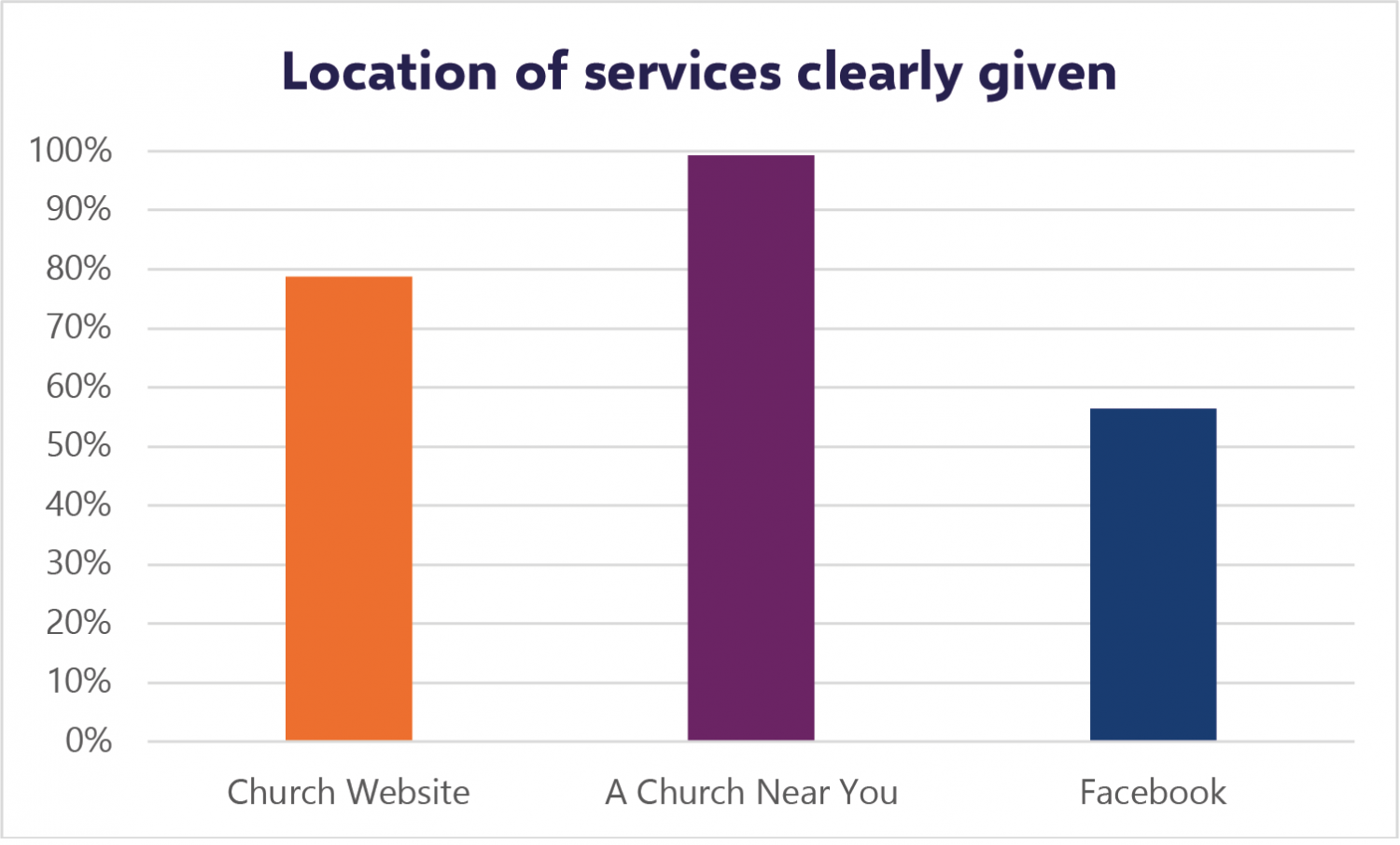1.Summary
This report presents an overview of churches’ online presence at Summer 2022. Every one of the 441 churches in the diocese was surveyed with the intention of indicating how accessible and informative our online presence is.
Online presence is now the first stop for many who seek to join us for worship or engage in occasional offices. Our website or Facebook page can be as important as the church noticeboard or the Sunday morning welcome in helping people join us.
The report was prepared to provide diocesan staff, senior clergy and churches with a picture of the current position. The report records both data and methods so that it can be repeated in the future to provide a picture of ongoing progress.
Key findings are:
- Almost every church has an active online presence;
- The main platforms for a church’s online presence are:
- A church’s own website
- A Church Near You (ACNY)
- Most churches’ online platforms have an accurate location of their place of worship, and contact details;
- Many churches are not keeping all their platforms up to date and some are out of date across all platforms;
- A significant number of churches have not met requests for safeguarding information to be prominently displayed.
2.Purpose
Background
-
Covid
The Covid-19 pandemic has presented both challenges and opportunities for our churches in ways that few could have envisaged three years ago, with many churches developing forms of virtual worship in response to first impossibilities and then restrictions with in-person worship. Yet online presence in its simplest form remains a key point for enquirers: what is this church? Where and when does it meet? Can I contact it easily?
-
Previous surveys and work
A survey with similar questions was carried out in 2018 and 2019 by the then Diocesan Online Enabler Tamar Willoughby. Although the majority of the diocese was covered, it was never completed at that stage.
In April 2020, during the first lockdown, Mission Team Co-ordinator Richard Barrett completed a survey using a similar method to estimate how many churches were delivering online worship. A summary of this can be seen at; www.lichfield.anglican.org/online-services-survey--april-2020.php
Method
-
Method used
Co-ordinated by colleagues from the Mission Team and the Communications Team, a survey of all the diocese’s churches was made. The work was carried out internally, with Richard Barrett carrying out much of the data collection, aggregation and analysis.
A systematic search for all the diocese’s churches was made, deanery by deanery, searching for any web presence on any of A Church Near You, Facebook, Instagram, or a church’s own website. These web presences were then checked against the questions listed in Appendix One.
For consistency of data each individual church was treated as a unit, although in fact, on every platform but A Church Near You, churches regularly work together on their online presence (e.g. across benefices, groups and teams).
The survey was structured to avoid qualitative judgments about content. Most of the questions used in the survey could be answered with a simple ‘yes’ or ‘no’, helping to keep analysis as consistent and clear-cut as possible. In other cases numeric fields were used, e.g. in the event of churches having a Facebook or Instagram page, the number of days since the last update was made.
-
Observations on the method of the survey
The survey was conducted one deanery at a time, platform-by-platform (i.e., first searching for any online presence, then Instagram, then Facebook, then A Church Near You, then any specific webpages). This may have made it harder to spot contradictory information being given across platforms such as varying service times.
After piloting the survey in four deaneries, the categories for safeguarding on a specific church website were refined from two to three categories:
- A full and appropriate safeguarding statement is included on the front page.
- Such a statement exists and is only a single-click from the front page.
- There is no appropriate safeguarding statement, or if it is more than one click away from the front page.
3. Results
How many churches have an online presence?
All but one of the churches in the diocese have some form of online presence. The exception is Pradoe Church in Shrewsbury Episcopal Area which is in an extra-parochial area.
All but five churches in the diocese have their own A Church Near You page. The five churches for which a current ACNY page could not be located were in distinct categories; Aldridge Hothouse, Connect2, Deaf Church, Pradoe, and Wolverhampton Pioneer Ministries.
What online presence do churches have?
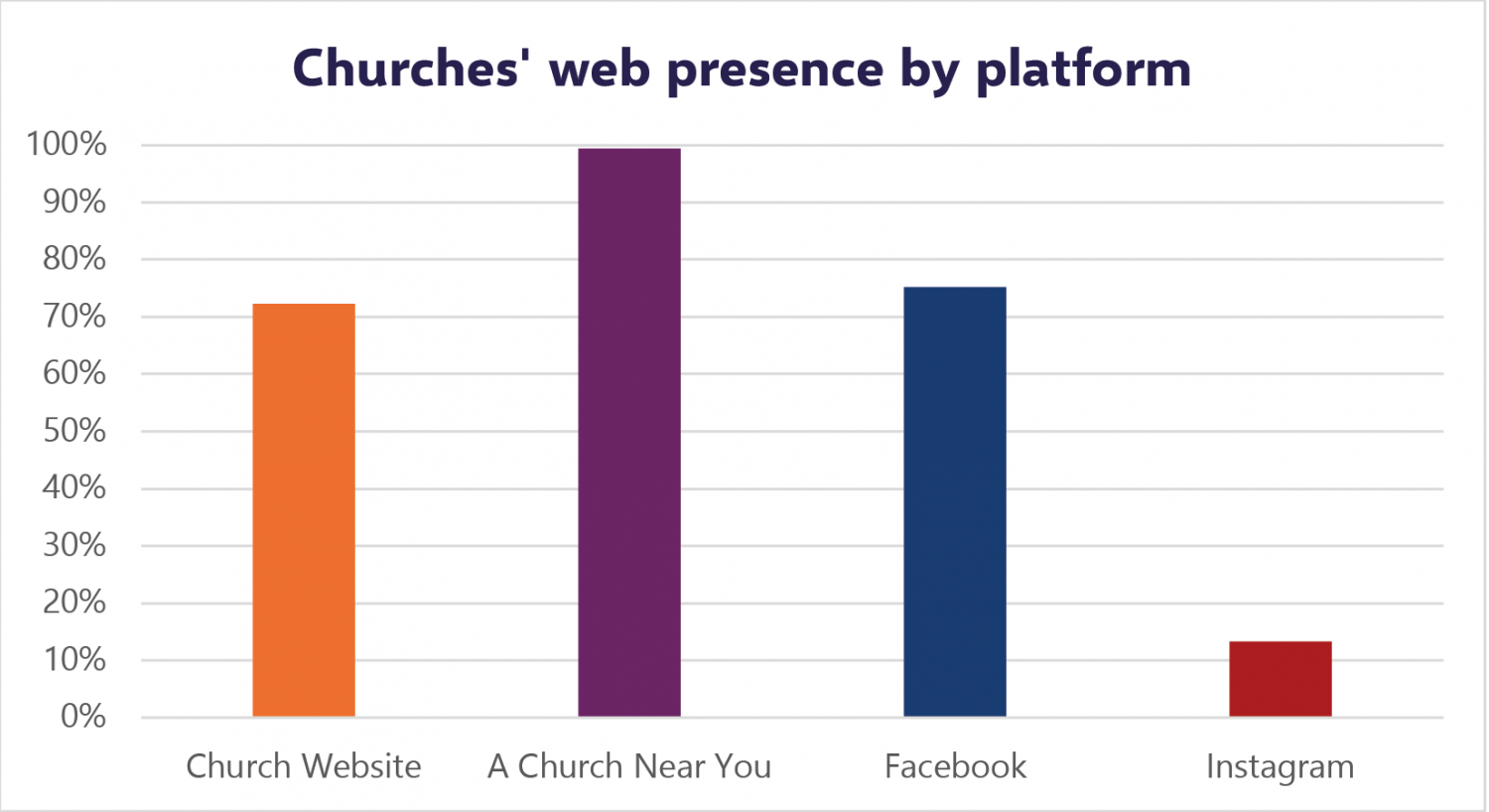 When the survey was conducted during late Spring and early Summer 2022:
When the survey was conducted during late Spring and early Summer 2022:
- 72% of our churches had a webpage (which might be dedicated to them or shared with several in a group, team or benefice).
- 75% of our churches had a Facebook page.
- 13% of our churches had an Instagram page.
How many are up to date?
-
How was this measured?
The following indicators were used to give an impression of whether a church’s platforms were up to date.
In the case of ACNY and church websites, it is hard to demonstrate that the platform is up to date, and easier to identify that it is out of date. To indicate this, a check of pages was made. Where ‘upcoming events’ were in the past, or former staff were still displayed etc, the site was noted as not being up to date.
This means that the true proportion of these platforms recorded as out of date is almost certainly higher than the figure given. There will have been some changes that the researcher will not have known about (e.g. changes to service times).
In the case of Facebook and Instagram, the number of days since the last update was noted on the day of the survey. As both Facebook and Instagram clearly give the date of the last update, this was a simpler process.
-
What did we observe?
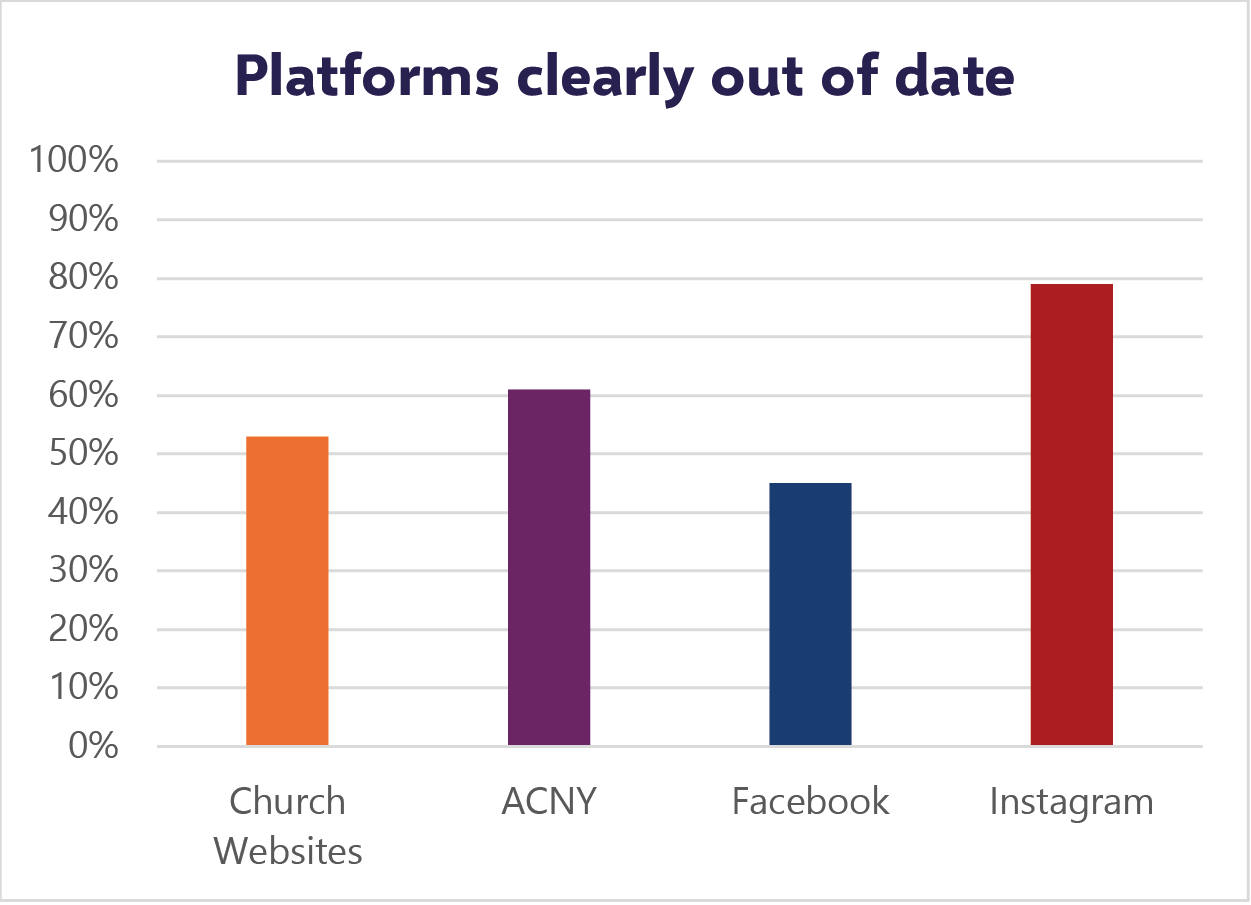
Church websites:
53% of churches’ websites had material that was clearly out of date.
ACNY:
61% of ACNY pages had material that was clearly out of date.
Facebook:
55% of FB pages had been updated within six days.
Instagram:
21% of Instagram pages had been updated within six days.
OVERALL:
94 churches had posted within six days on Facebook, and did not appear to be presenting out-of-date information on their own website if they had one.
170 churches had posted within six days on Facebook, but were out of date on at least one other platform.
133 churches were noted as out of date on every platform they were using and had not posted on Facebook within six days.
What is the quality of the information provided online?
-
How was this measured?
Each platform was checked for the church’s:
- meeting location;
- meeting times;
- means of contact.
For Facebook, a check was also made to see whether the name of the page contained the name and place of the church (e.g. St Chad’s Lichfield). This is because it can be hard to find and identify the correct Facebook page for any given church, and the page name is critical in enabling that.
-
What was observed?
Meeting location:
99% of our churches had their worship location given on ACNY, 78% on their own website (where they had one), and 56% on any Facebook page.
Times:
84% of church websites clearly gave their service times. For ACNY this figure was 81%. 50% of church Facebook pages clearly gave their meeting times.
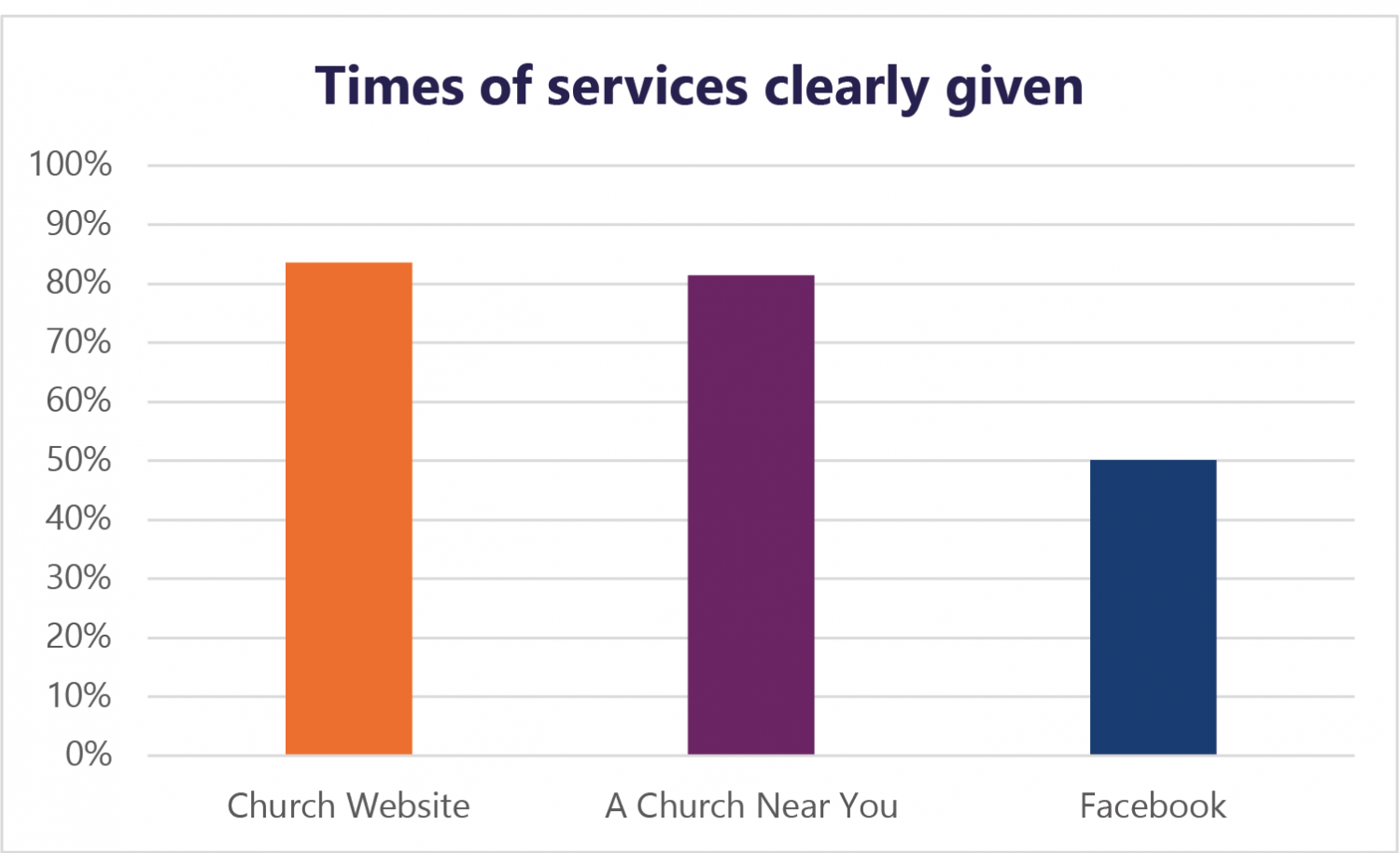
Contact:
93% of church websites gave a clear means of contact, with 91% on ACNY pages providing similar. This question did not apply to Facebook pages, which have their own inbuilt message system. The contact was not tested by this survey: i.e. where an obsolete email address or telephone number, or a faulty online form is given, it was beyond the scope of this research to identify that.
Safeguarding and web presence
-
Context – why is this important at present?
In March 2019 parishes were reminded via the Diocesan Bulletin to ‘display info about their safeguarding arrangements’. The article pointed parishes to the Parish Safeguarding Handbook (House of Bishops, 2018) which states that a parish responsibility is to: ‘ensure that safeguarding arrangements are clearly visible on the front page of the parish website.’
-
What was observed?
Each church website and ACNY page was checked for a safeguarding statement in line with that expectation. The following text was used by the researcher as a benchmark for an ‘adequate safeguarding statement on the front page’:
"(Name of Church) is committed to Safeguarding and has adopted the National and Diocesan Safeguarding Policies. Our Safeguarding Coordinator is (Name of Safeguarding Coordinator) and can be contacted on (Enter a contact telephone number)”.
Using that benchmark, 36% of A Church Near You pages had an adequate safeguarding statement; and 28% of church websites had one.
During the research pilot, it was noted that many websites had an adequate safeguarding statement one direct click from the front page. This category was added to the survey, and 34% of church websites fell into it.
Of the remaining 38.4%, some had an adequate statement contained somewhere on the website, but more than one click away from the front page.
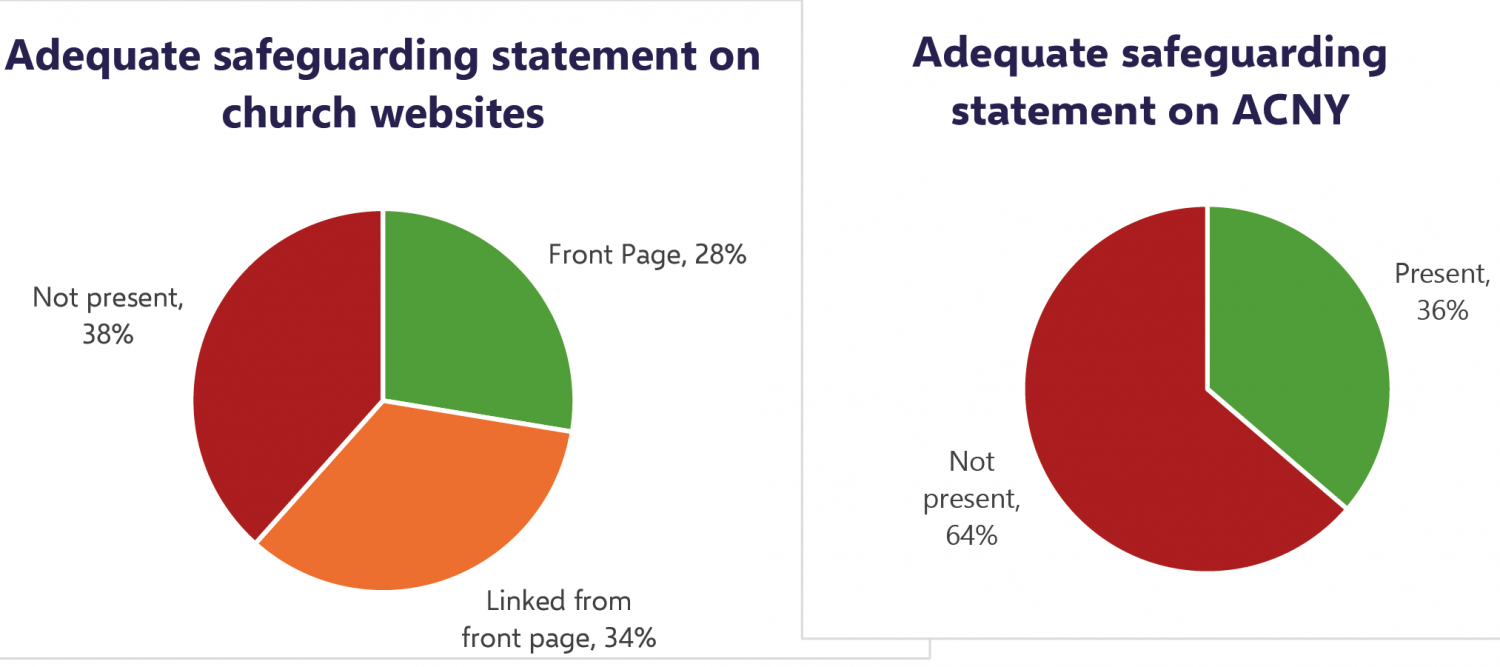
How easy is the church to find online?
-
How did we measure this?
In recent years, ‘search engine optimisation’ has been regarded as important for those wanting to communicate their presence online. It is considered that the further down an online search your site appears, the less likely people are to find it or rely on it. With this in mind the research sought to identify how often churches appeared on the first page (first ten results) of an online search.
The researcher used the following question as an indicator:
‘If you type the ‘Church of England ’ into Google, does either its website, its Facebook page, or its ACNY page come up on the first page of results?’
-
Findings
85% of our churches were found under that specific question, with at least one of their main platforms appearing on the first page of a search.
Of the remaining 15%, some recognition needs to be given as to the ambiguity of the specific name of some churches. Some places especially in medium-sized towns may have several churches known equally by the town or the suburb (e.g. ‘Leek All Saints, Compton’ and ‘Walsall St Andrew, Birchills’).
For others, the place name itself lent itself to very different search hits (e.g. the villages of ‘Hints’ and ‘Wall’ in Lichfield Deanery.)
Further analysis
-
Size
To analyse by size, six categories were used, based on the size of their Worshipping Community; 0-24 people, 25-49, 50-74, 75-99, 100-199, and 200 or over.
The likelihood of churches having their own website or Facebook pages generally increased with size, with churches of up to 74 people having a 60-80% likelihood of having their own website, increasing to an 80-95% if their numbers reach 75 people or above.

The availability of both locations and service times was also lowest in our smallest size category across all 3 surveyed platforms.


-
Rural, Urban and UPA
To analyse by context, three categories, widely used elsewhere across the diocese: rural, urban, and UPA (Urban Priority Area), were considered.
Church Websites and A Church Near You
Rural churches were less likely to have their own website at 63% than Urban or UPA ones (84% and 79% respectively).
Further analysis by context is shown in the tables below.
|
Rurality |
Church Website? |
|||||||||||
|
Exist? |
Location |
Times |
Contact |
Out of Date? |
Safeguarding? |
|||||||
|
Yes |
No |
Yes |
No |
Yes |
No |
Yes |
No |
Yes |
Yes |
Linked |
No |
|
|
UPA |
79 |
22 |
77 |
23 |
89 |
11 |
86 |
14 |
60 |
33 |
36 |
32 |
|
Urban |
84 |
162 |
87 |
13 |
91 |
9 |
96 |
4 |
45 |
24 |
37 |
39 |
|
Rural |
63 |
38 |
72 |
28 |
74 |
26 |
94 |
6 |
44 |
29 |
31 |
41 |
|
TOTAL |
72 |
28 |
79 |
21 |
84 |
16 |
93 |
7 |
47 |
28 |
34 |
38 |
|
Rurality |
A Church Near You |
||||||||
|
Venue |
Times |
Contact |
Out of Date |
Safeguarding |
|||||
|
Yes |
No |
Yes |
No |
Yes |
No |
Yes |
Yes |
No |
|
|
UPA |
100 |
0 |
88 |
12 |
86 |
14 |
57 |
30 |
70 |
|
Urban |
99 |
1 |
86 |
14 |
90 |
10 |
60 |
43 |
57 |
|
Rural |
99 |
1 |
76 |
24 |
93 |
8 |
62 |
34 |
66 |
|
TOTAL |
99 |
1 |
81 |
19 |
91 |
10 |
61 |
36 |
64 |
Urban churches were most likely to have a Facebook page at 87%, compared with 81% for UPA churches and 65% for rural ones.
- Rural churches scored fewest in those Facebook pages that existed also;
- 39% clearly gave the name of the church compared to 74% Urban and 77% UPA.
- 30% clearly gave their church location compared to 81% Urban and 81% UPA.
- 36% clearly gave their service times compared to 60% Urban and 63% UPA.
|
Rurality |
|
||||||||||||
|
Page |
Name |
Location |
Times |
Days since Update |
|||||||||
|
Yes |
No |
Yes |
No |
Yes |
No |
Yes |
No |
0-1 |
2-6 |
7-28 |
29-364 |
365+ |
|
|
UPA |
81 |
19 |
77 |
23 |
81 |
19 |
63 |
37 |
24 |
36 |
21 |
13 |
5 |
|
Urban |
87 |
13 |
74 |
26 |
81 |
19 |
60 |
40 |
38 |
29 |
18 |
10 |
6 |
|
Rural |
65 |
35 |
39 |
61 |
30 |
71 |
36 |
64 |
25 |
18 |
38 |
14 |
5 |
|
TOTAL |
75 |
25 |
60 |
41 |
59 |
41 |
50 |
50 |
30 |
25 |
27 |
12 |
5 |
-
Archdeaconry
The following table offers the survey results categorised across the four archdeaconries (Lichfield, Salop, Stoke, andWalsall).
Websites
|
Archdeaconry |
Church Website? |
|||||||||||
|
Exist? |
Location |
Times |
Contact |
Out of Date? |
Safeguarding? |
|||||||
|
Yes |
No |
Yes |
No |
Yes |
No |
Yes |
No |
Yes |
Yes |
Linked |
No |
|
|
Lichfield |
72 |
28 |
80 |
20 |
91 |
9 |
97 |
3 |
48 |
9 |
23 |
67 |
|
Salop |
79 |
21 |
87 |
13 |
87 |
13 |
97 |
3 |
45 |
39 |
33 |
28 |
|
Stoke |
63 |
37 |
71 |
29 |
74 |
26 |
92 |
8 |
52 |
28 |
34 |
37 |
|
Walsall |
82 |
18 |
79 |
21 |
89 |
11 |
88 |
12 |
68 |
25 |
43 |
32 |
|
TOTAL |
72 |
28 |
79 |
21 |
84 |
16 |
93 |
7 |
53 |
28 |
34 |
38 |
A Church Near You
|
Archdeaconry |
A Church Near You |
||||||||
|
Venue |
Times |
Contact |
Out of Date |
Safeguarding |
|||||
|
Yes |
No |
Yes |
No |
Yes |
No |
Yes |
Yes |
No |
|
|
Lichfield |
98 |
2 |
85 |
15 |
90 |
10 |
64 |
40 |
60 |
|
Salop |
99 |
1 |
76 |
24 |
89 |
11 |
86 |
25 |
75 |
|
Stoke |
100 |
1 |
82 |
18 |
95 |
5 |
36 |
39 |
61 |
|
Walsall |
100 |
0.0 |
86 |
14 |
84 |
17 |
72 |
44 |
56 |
|
TOTAL |
99 |
1 |
81 |
19 |
91 |
10 |
61 |
36 |
64 |
|
Archdeaconry |
|
||||||||||||
|
Page |
Name |
Location |
Times |
Days since Update |
|||||||||
|
Yes |
No |
Yes |
No |
Yes |
No |
Yes |
No |
0-1 |
2-6 |
7-28 |
29-364 |
365+ |
|
|
Lichfield |
74 |
26 |
80 |
20 |
61 |
39 |
50 |
50 |
51 |
19 |
14 |
11 |
6 |
|
Salop |
78 |
22 |
35 |
65 |
43 |
57 |
37 |
63 |
25 |
27 |
30 |
12 |
7 |
|
Stoke |
69 |
31 |
53 |
47 |
50 |
50 |
57 |
43 |
21 |
28 |
39 |
9 |
4 |
|
Walsall |
86 |
14 |
77 |
24 |
84 |
17 |
57 |
44 |
34 |
24 |
15 |
21 |
6 |
|
TOTAL |
75 |
25 |
57 |
43 |
56 |
44 |
50 |
50 |
30 |
25 |
28 |
12 |
5 |
4. What conclusions do we draw?
Looking at the data, the main conclusions seem to be:
- Almost every church has an active online presence, and most maintain more than one platform.
- The main platforms for a church’s online presence are:
- A church’s own website
- A Church Near You (ACNY)
- Instagram is less widely used, and where a church has an Instagram page it is rarely maintained.
- Most churches’ online platforms have an accurate location of their place of worship, and contact details. Across the diocese as a whole, the time and location of worship seems to be less well communicated on Facebook than on other platforms.
- Many churches are not keeping all their platforms up to date and some are out of date across all platforms. A Church Near You pages are much more likely to be out of date than church websites.
- A significant number of churches have not yet followed national guidance for safeguarding information to be prominently displayed. This was much more true of A Church Near You pages than church’s websites. However, for church websites, there are strong variations across archdeaconries.
Appendix One – Survey Questions
Church’s own website
- Is the address for the church (or worship meeting place) easily accessible on the website? (one click from front page)
- Are times of worship easily accessible on the website? (one click from front page)
- Can you see how to contact the church on the website?
- Is there easily accessible information about upcoming worship/events? (one click from front page)
- Is there an adequate safeguarding statement on the front page?
A Church Near You (ACNY) page
- Is the address for the church (or worship meeting place) easily accessible on the website? (one click from front page)
- Are times of worship easily accessible on the website? (one click from front page)
- Can you see how to contact the church on the website?
- Is there information about upcoming worship/events?
- Is there an adequate safeguarding statement on the front page? ("(Name of Church) is committed to Safeguarding and has adopted the National and Diocesan Safeguarding Policies. Our Safeguarding Coordinator is (Name of Safeguarding Coordinator) and can be contacted on (Enter a contact telephone number)”.)
Search Engine Optimisation
- If you type the ‘Church of England ’ into Google, do either its website, its Facebook page, or its ACNY page come up on the first page of results?
- Is there a Facebook page?
- Does its name contain the name of the church AND the name of the place?
- Can you find out where the church meets from here? (either from the page itself or via an obvious link to website)
- Can you find out when worship takes place from here (either from the page, or linking to the website)
- How many days since the last post was made?
- Does this church have an Instagram profile?
- If so, how many days since the last post was made?
Appendix Two - Safeguarding
The current guidance for parishes remains that issued by the House of Bishops in 2018. https://www.churchofengland.org/sites/default/files/2019-10/ParishSafeGuardingHandBookAugust2019Web.pdf
It states that one of a parish’s responsibilities is to:
Ensure that safeguarding arrangements are clearly visible on the front page of the parish website.
And adds:
Some parishes do not have their own website. In this situation, the parish may want to offer some information on the A Church Near You website.
Churches looking to include safeguarding information on their own websites may like to view the following examples:
Website
Haughmond and Wrekin : www.haughmondandwrekin.org.uk
A Church Near You
Wombridge St Mary and St Leonard: https://www.achurchnearyou.com/church/4656/
